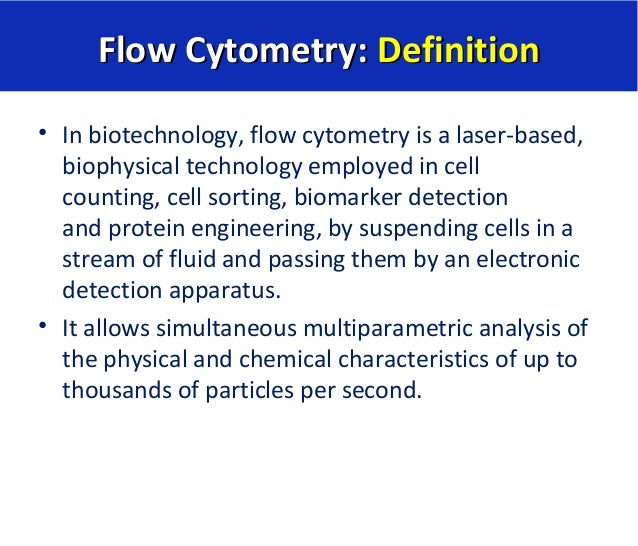
Cell populations are marked by their probable identity: D Presumed debris, very small items with low low forward- and side- scatter.

Image: A mock flow cytometry dot-plot, plotting forward vs side-scattered from a population of leukocytes.
#Define cytometry series
A series of sensors detect the types of light that are refracted or emitted from the cells.Light is used to illuminate the cells in the channel.Sample cells are passed through a narrow channel one at a time.clusters of differentiation or CD markers) can be used to better identify and segregate specific sub-populations within a larger group. When additional information is required, antibodies tagged with fluorescent dyes, and raised against highly specific cell surface antigens (e.g. For example, in immunology flow cytometry is used to identify, separate, and characterize various immune cell subtypes by virtue of their size and morphology. Flow cytometry is a particularly powerful method because it allows a researcher to rapidly, accurately, and simply collect data related to many parameters from a heterogeneous fluid mixture containing live cells.įlow cytometry is used extensively throughout the life and biomedical sciences, and can be applied in any scenario where a researcher needs to rapidly profile a large population of loose cells in a liquid media. Originally developed in the late 1960s, flow cytometry is a popular analytical cell-biology technique that utilizes light to count and profile cells in a heterogenous fluid mixture. Custom Recombinant Antibody (rAbs) Services.Annexin V-FITC Apoptosis Detection Kits.
#Define cytometry full
© 2017 International Society for Advancement of Cytometry.Ĭossarizza A, Chang HD, Radbruch A, Acs A, Adam D, Adam-Klages S, Agace WW, Aghaeepour N, Akdis M, Allez M, Almeida LN, Alvisi G, Anderson G, Andrä I, Annunziato F, Anselmo A, Bacher P, Baldari CT, Bari S, Barnaba V, Barros-Martins J, Battistini L, Bauer W, Baumgart S, Baumgarth N, Baumjohann D, Baying B, Bebawy M, Becher B, Beisker W, Benes V, Beyaert R, Blanco A, Boardman DA, Bogdan C, Borger JG, Borsellino G, Boulais PE, Bradford JA, Brenner D, Brinkman RR, Brooks AES, Busch DH, Büscher M, Bushnell TP, Calzetti F, Cameron G, Cammarata I, Cao X, Cardell SL, Casola S, Cassatella MA, Cavani A, Celada A, Chatenoud L, Chattopadhyay PK, Chow S, Christakou E, Čičin-Šain L, Clerici M, Colombo FS, Cook L, Cooke A, Cooper AM, Corbett AJ, Cosma A, Cosmi L, Coulie PG, Cumano A, Cvetkovic L, Dang VD, Dang-Heine C, Davey MS, Davies D, De Biasi S, Del Zotto G, Dela Cruz GV, Delacher M, Della Bella S, Dellabona P, Deniz G, Dessing M, Di Santo JP, Diefenbach A, Dieli F, Dolf A, Dörner T, Dress RJ, Dudziak D, Dustin M, Dutertre CA, Ebner F, Eckle SBG, Edinger M, Eede P, Ehrhardt GRA, Eich M, Engel P, Engelhardt B, Erdei A, Esser C, Everts B, Evrard M, Falk CS, Fehniger TA, Felipo-Benavent M, Fer… See abstract for full author list ➔ Cossarizza A, et al. LED light source background light calibration characterization dynamic range signal-to-noise ratio standardization. © 2017 International Society for Advancement of Cytometry. Finally, with this method, it becomes clear that increased SNR comes at the expense of DNR and thus the limiting factor of modern cytometers is the DNR. SNR and DNR are stand-alone values that allow the direct comparison of different instruments. We further introduced a decibel (dB) scale for the presentation of SNR and DNR values. This allows the selection of a voltage/gain corresponding to a PMT's maximum efficiency and hence the lowest electronic noise, which can help with experiment design.

As a consequence, we propose a practical method to characterize a cytometer's signal-to-noise ratio (SNR) and dynamic range (DNR).

We, therefore, characterized the instrument's response over the entire PMT voltage range. Here, we describe how this light source can be used to characterize a cytometer's PMT performance. The introduction of such a light source, the quantiFlash TM, gave this possibility. The theory for scale calibration was proposed by Steen over two decades ago, but it has never been put into regular use due to the lack of a widely available precision light source. A well-defined scale calibration in flow cytometry can improve many aspects of data acquisition such as cytometer setup, instrument comparison and sample comparison.


 0 kommentar(er)
0 kommentar(er)
